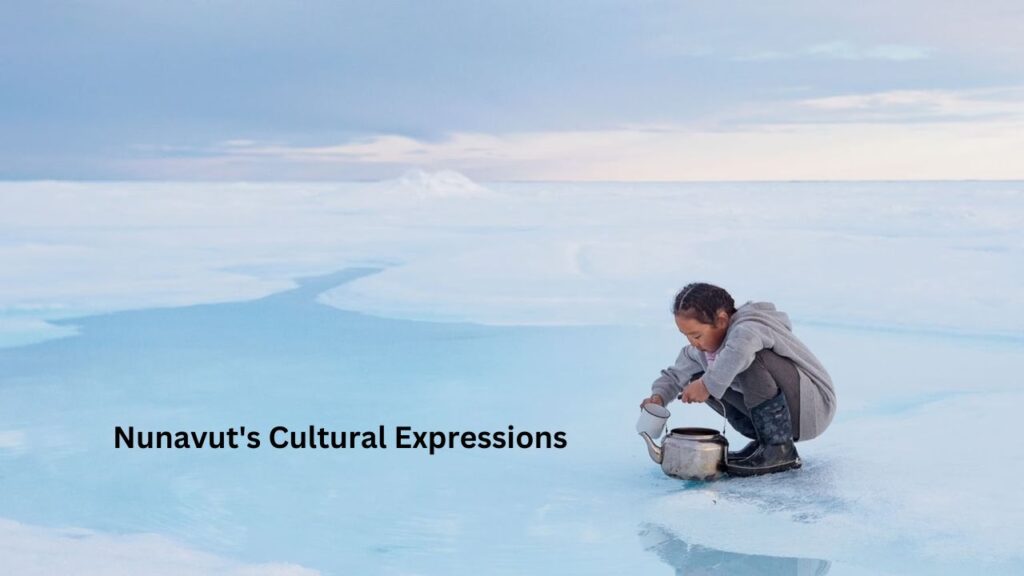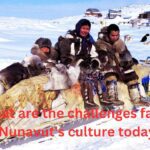Nunavut, Canada’s northernmost territory, is a land where the cultural expressions of the Inuit people are deeply intertwined with the natural environment and their way of life. Established in 1999, Nunavut is home to a predominantly Inuit population that has lived in the Arctic for thousands of years, adapting to one of the harshest climates on Earth. The cultural expressions of Nunavut—spanning art, language, music, storytelling, and traditional practices—are rich and diverse, rooted in ancient customs while evolving to reflect contemporary realities. A journey through these cultural expressions offers a glimpse into the resilience, creativity, and spiritual depth of Nunavut’s people.
1. Inuit Art: A Window into Life in the Arctic
One of the most recognized cultural expressions of Nunavut is Inuit art, which reflects the intimate relationship between the people and their environment. Inuit artists have long used the resources available in their surroundings—such as soapstone, bone, ivory, and walrus tusk—to create intricate sculptures that depict the animals, people, and landscapes of the Arctic. The themes of Inuit art often focus on the essential elements of Inuit life: hunting, survival, spirituality, and the natural world.
Carving, in particular, has become an iconic form of Inuit artistic expression. Artists like Kenojuak Ashevak, one of Nunavut’s most celebrated artists, created works that capture the mysticism of the Arctic, portraying animals such as birds, seals, and polar bears with intricate detail. In recent years, Inuit artists have expanded their mediums to include printmaking, painting, and photography, but the tradition of carving remains a vital part of Nunavut’s cultural landscape. Art, for the Inuit, is not just a form of aesthetic expression but a means of preserving and passing down knowledge, stories, and the values of the community.
2. Language: The Heart of Inuit Identity
At the core of Nunavut’s cultural expression is the Inuit language, Inuktitut, which plays a central role in maintaining cultural identity and preserving traditional knowledge. Inuktitut is deeply connected to the land and the Arctic environment, with words and phrases that describe the natural world, wildlife, and weather patterns in intricate detail. Language is a vital tool for storytelling, the transmission of wisdom, and the teaching of survival skills.
In Nunavut, Inuktitut is the official language, and there are concerted efforts to preserve it through bilingual education programs in schools and government initiatives. Language is a living expression of culture, and the revitalization of Inuktitut is seen as essential to maintaining Inuit traditions. As Inuit communities face the pressures of globalization and modernization, the survival of the language has become an urgent priority. Through community programs, language courses, and the promotion of Inuktitut in public life, Nunavut is fostering a cultural renaissance that emphasizes the importance of language in shaping identity.
3. Storytelling: Oral Traditions and Cultural Transmission
Oral storytelling is a vital cultural expression that has been used by the Inuit for centuries to pass down knowledge, history, and wisdom. Elders are highly revered in Inuit culture for their vast knowledge and experience, and they play an essential role in preserving traditional stories, legends, and teachings. These stories often contain lessons on survival, moral conduct, and the relationship between humans, animals, and the environment.
Stories about the creation of the world, encounters with spirits, and tales of mythical creatures help to frame the Inuit worldview. Through storytelling, younger generations learn how to navigate their environment, understand social roles, and honor their cultural heritage. Today, storytelling remains a core part of community life, with modern forms of communication—such as radio programs, podcasts, and online videos—providing new platforms for elders and storytellers to share their knowledge.
4. Music and Dance: Rhythms of the North
Music and dance are integral to the cultural expressions of Nunavut, often serving as both forms of entertainment and spiritual rituals. Traditional Inuit music is deeply tied to the rhythms of the land and the seasons. Drumming, in particular, holds special significance, as it is believed to connect people with the spiritual world. The beat of the drum imitates the heart of the earth and is used in ceremonies to invoke spirits or to call for successful hunts.
Traditional Inuit dance is another important cultural practice, often performed as part of social gatherings or celebrations. The dances are usually accompanied by songs and drumming, with movements that imitate animals, nature, and daily activities. These performances not only celebrate Inuit life but also serve as a reminder of the importance of community and the relationship between people and the environment.
In modern Nunavut, traditional music and dance continue to thrive, with Inuit artists blending contemporary genres like folk, rock, and hip-hop with traditional sounds. This fusion of old and new reflects the resilience and adaptability of Nunavut’s cultural expressions in the face of global change.
5. Hunting and Survival Skills: Cultural Knowledge in Practice
A key cultural expression in Nunavut is the practice of hunting, which is not only essential for survival but also a deeply symbolic activity. Inuit hunting traditions are rich with rituals, teachings, and respect for the animals that sustain the people. Hunting and fishing are passed down through generations, and young Inuit learn the skills from their elders through hands-on experience.
The knowledge required for hunting—such as the understanding of animal behavior, ice conditions, and weather patterns—forms the basis of Inuit traditional knowledge, or Inuit Qaujimajatuqangit (IQ). This body of knowledge is transmitted through practical experience, stories, and teachings about the importance of respecting nature and maintaining a balanced relationship with the environment.
6. Cultural Adaptation and Modern Expressions
While traditional expressions remain a central part of life in Nunavut, the Inuit people are also finding ways to incorporate modern influences into their cultural practices. Contemporary art, literature, music, and media are increasingly used to express Inuit experiences and address current social issues such as climate change, land rights, and cultural survival. The use of technology and social media has allowed Inuit artists, activists, and storytellers to reach global audiences and share their perspectives, while also celebrating the vibrancy and adaptability of Inuit culture.
Conclusion
A journey through Nunavut’s cultural expressions reveals a vibrant tapestry of traditions, values, and creativity that have been shaped by the land, the people, and the harsh Arctic environment. From the art that reflects the close relationship with animals to the language that carries centuries of knowledge, from the rhythms of traditional music to the storytelling that binds generations together, Nunavut’s cultural expressions are both a living heritage and a dynamic response to the challenges of the modern world. Through these expressions, the Inuit people of Nunavut continue to affirm their identity and resilience, ensuring that their culture thrives in the 21st century.



